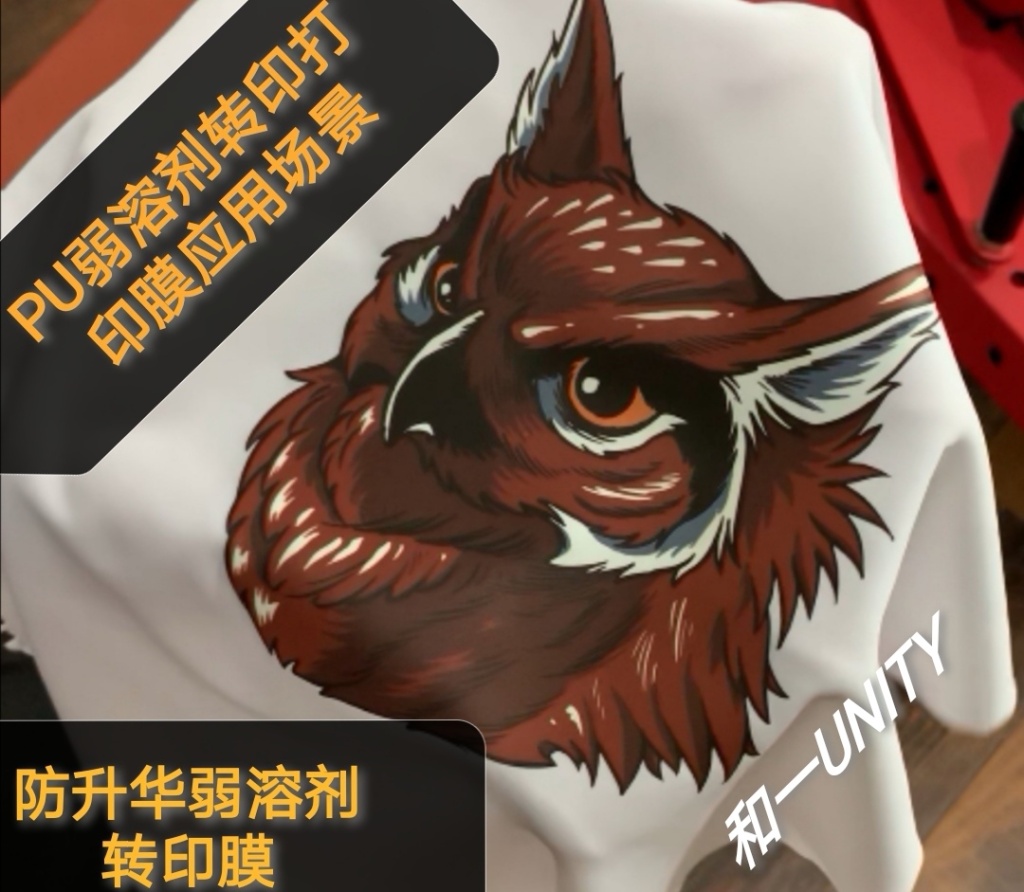Weak Solvent Thermal Transfer Printing Film for Anti-Sublimation
The product may react with the dyeing agent, leading to sublimation issues. The sublimation is determined by the composition of different fabrics and the dyeing process.
The main problem we encounter is that after fabric is ironed, due to the instability of the dye on the fabric, after long-term storage, the dye on the fabric may migrate to the surface of the printing film, which can affect the appearance of the heat transfer printing and make it less attractive.
Problems with different fabrics:
(1) Cotton: For example, if you iron a T-shirt on a dark fabric, the edges may become transparent or show the glue, which is often referred to as "white edges" (except for the so-called "white run").
(2)、Polyester fabric: For example, when using cycling clothing, polyester fabric is prone to sublimation, so it is important to communicate with customers.
(3)、Nylon fabric: For down jackets, the fabric is made of warp-knitted fabric, with an additional water-repellent coating (PU, PVC, or silicon) on the surface, which makes the fabric impractical for breathability, smooth to the touch, prone to explosive glue, not heat-resistant, and can easily come off with washing. Additionally, the fabric itself is not heat-resistant, and it can be damaged by high temperatures.
(4) Leather: For example, in suitcases, there are mainly PU leather, PVC leather, and real leather. To increase the softness of PVC leather, plasticizers are added, which can react with glue, making the heat transfer image easily peeled off when the hands are rubbed. Always make sure to ask the customer what kind of leather they are using when communicating with them.
Detection method for fabric anti-sublimation effect:
1. Set the direct transfer and ironing temperature at 150°C, time 10-30 seconds, and press the test process multiple times.
2. Dehumidification chamber set temperature at 50℃, product placed inside for 7 days of dehumidification.
3. Set the heat transfer machine to a temperature of 150-160°C and bake it on the heating plate for 30 minutes.
4, Observe the product for more than 3 months after transfer.
Product appearance: The back of the product is black, which is the color of the barrier layer.
Features: No delamination after high-temperature transfer, no deformation, high rebound stretch, good resistance to washing and weathering.


Product Advantage: The PU printing film with weak solvent heat transfer film has been specially treated to prevent the fabric from experiencing secondary sublimation, offering high coverage and strong adhesion.
Use operation
1. Image Printing
Install the dark-colored weak solvent heat transfer paper on the suitable printer, set the relevant printing parameters according to actual needs, output the required image through the computer and printer, and present it on the heat transfer paper.
2. Image Crop
The image is first processed through a Photoshop cutting path, and then the printed image outline is cut using a engraving machine.
3、Coating Transfer
Remove the adhesive film from the blank areas and the cut-out parts of the image, followed by treating the waste (disposal). Then, use a cold laminating machine to apply the specialized matching positioning film (transfer film) to the surface of the image, and finally peel it off to transfer the image to the positioning film (transfer film).
4、Image Pressing
Preheat the heat transfer machine to the appropriate transfer temperature of 150°C (subject to conditions, recommend measuring the temperature).
— Place the front of the image face up on the supporting object.
The heat transfer machine is set to medium pressure, with a pressure time of about 15 seconds. The item to be transferred is removed and allowed to cool before peeling off the positioning film (transfer film).
5、Washing
―After hot stamping, do not wash within 24 hours.
― Use lukewarm water or cold water below 40℃ to wash, do not use bleach or very alkaline detergent, avoid rubbing the transferred image too hard, do not wring it dry, and do not expose it to direct sunlight.
―Not for dry cleaning.



